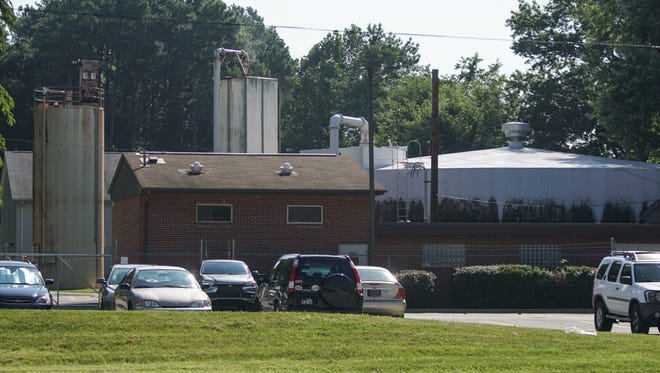Superfund dollars could help Newark water cleanup
 Karl Baker
Karl Baker
About 3 miles from Newark's bustling Main Street lies the Del. 72 corridor – an area lined with light-industrial buildings, commercial retailers and a city well-water plant.
Underneath those facilities are two polluted plumes of groundwater.
State environmental regulators say someone in the area, possibly decades ago, allowed a volatile organic compound, called tetrachloroethylene, to leach underground.
U.S. Environmental Protection Agency officials describe the chemical as a carcinogen and say it is widely used in dry cleaning, textile processing and metal degreasing operations.
The search for the culprit – a state effort that has been ongoing for more than a decade – now may involve the Environmental Protection Agency after the Delaware Department of Natural Resources and Environmental Control requested federal assistance.
EPA officials on Monday began a lengthy process to place the contaminated groundwater site on its National Priorities List, a designation that would allow federal Superfund dollars to flow to investigative and cleanup efforts at the polluted area along Del. 72, between Del. 4 and I-95.
A 60-day public comment period on the proposed listing now ensues. If comments do not alter a hazard assessment, the site will become eligible for Superfund dollars.
It will "enable us to further our efforts to better understand the extent of ground water contamination in the Newark area,” DNREC Secretary Shawn Garvin said.
The Superfund program is responsible for cleaning up the country's most polluted sites. Program dollars also contribute to responses to environmental emergencies, oil spills and natural disasters, according to the EPA.

The polluted area, designated the Newark South Groundwater Plume, is one of four sites across the country being considered for inclusion on the Superfund list. As of June, a total of 1,336 sites were on the list.
An EPA spokesman did not respond Tuesday to a list of questions posed by The News Journal, including the amount of federal money that could be unleashed in Newark by the designation.
Other Superfund sites across the country have received hundreds of millions of cleanup dollars.
EPA Administrator Scott Pruitt in a report last month said he wants officials to speed up remediation efforts at Superfund sites nationwide. He also wants the agency to provide incentives to encourage private investment in environmental projects.
Tim Ratsep, DNREC's environmental program administrator, said in Newark the EPA first will conduct an evaluation at the site to determine the scope of cleanup that is necessary.
Remediation costs ultimately should be paid for by the still-to-be-identified polluter, Ratsep said, an amount that has not yet been determined.
During the past six months, DNREC officials sent letters to all business owners in the area, both current and past, requesting information about their operations, Ratsep said.
DNREC's investigations have identified several potential source areas, according to a statement from the EPA.
STORY: $50M settlement approved for DuPont mercury contamination
STORY: In Delaware, C8 contamination blamed on firefighting foam
Pollution identified two decades ago
DNREC officials in 1994 found trace levels of volatile organic compounds at four Newark water supply wells while conducting water sample analyses. In 2002, state officials again sampled water near the wells and detected tetrachloroethylene.
The city of Newark responded in 2003 by installing a $541,000 treatment system to filter the chemical from six public supply wells – water destined for the city's municipal supply.
DNREC in 2006 reimbursed Newark for those costs, according to city spokeswoman Kelly Bachman.
It is "a remediation device that essentially introduces air over cascading water," said Mark Neimeister, Newark's water operations superintendent. “Thankfully, it’s one of the easiest (volatile organic compounds) to remediate via the technology we have in place.”
Both Neimeister and DNREC officials stress that the city water is clean and safe to drink, pointing to their continuous tests that show it meets both EPA and state water-quality standards.
“We work day and night to ensure the water meets all health standards," Neimeister said.
The state of Delaware's maximum allowable contaminant level for tetrachloroethylene in drinking water is one part per billion. The EPA's maximum is five parts per billion.
Newark's municipal water system serves about 40,000 residents, pumping 3.4 million gallons each day. Roughly 37 percent of the water is pumped out of groundwater supply wells.
While the drinking water is safe, Neimeister said, the surrounding environment still is not free of the chemical. That is where the EPA comes in, he said.
In 2010, DNREC requested funding from the EPA to conduct a preliminary assessment in Newark to help identify the potential source of the pollution.
The assessment identified multiple areas of potential environmental concern, according to DNREC, but no one had been identified as the culprit.
The federal dollars will allow the process to continue, Neimeister said.
"The state obviously has financial issues right now, so there’s a lot more resources at the EPA to put into environmental cleanup,” he said,
|
Contact Karl Baker atkbaker@delawareonline.com or (302) 324-2329. Follow him on Twitter @kbaker6.